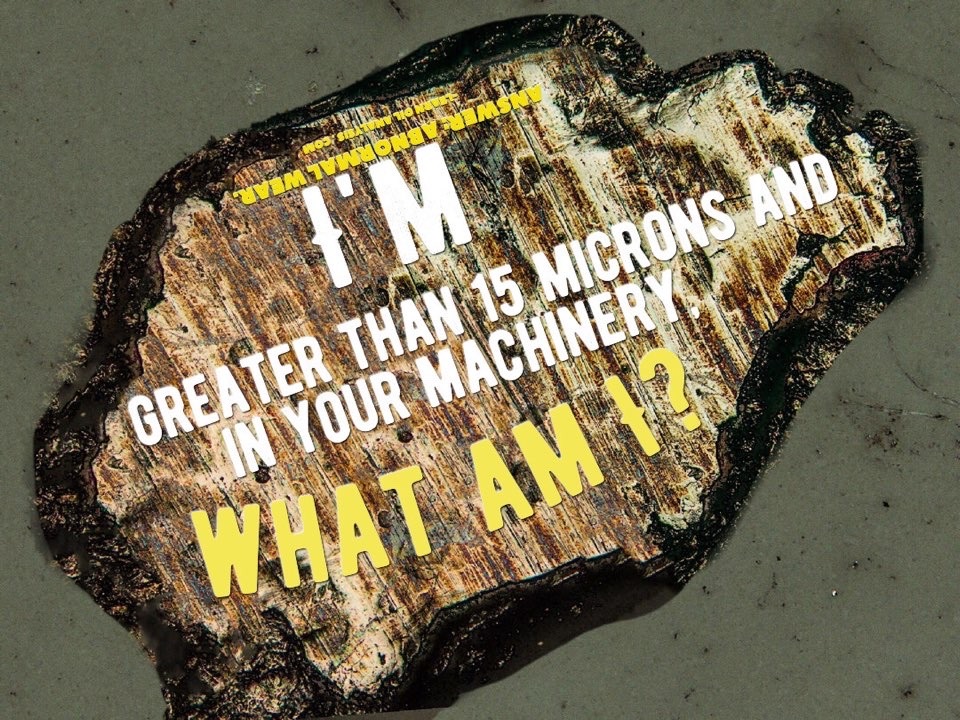All machines wear, that’s a fact. It doesn’t matter how great your lubricant is, nothing can stop wear taking place entirely when there are moving parts.
So why does wear happen in the first place?
Wear is a normal part of your machinery health. No surface is perfectly smooth and even when you look at metal surfaces with a mirror smooth finish, at the microscopic scale the surface looks like a mountain range. These microscopic surface imperfections are called asperities. When a new machine starts for the first time there is a lot of wear as the asperities start to get bent and break off as the two moving surfaces asperities contact one another bridging the gap across the lubricant film. This “running in” wear eventually reacts with anti-wear additives in the oil and forms a toughened metal and additive mix at the surface called the boundary lubrication layer, also known as the shear-mix layer.
What is normal wear?
This boundary lubrication layer is what continues to wear at low levels throughout the life of the machinery. The particles generated are usually very small, generally 5 microns or smaller, but can be up to 15 microns in size depending on the type of the equipment. To put that into perspective a human red blood cell is around 5 or 6 microns, the width of a human hair is around 80 microns and the tiniest speck you can possibly see by eye is around 40 microns.
So what is abnormal wear?
Abnormal wear particles by definition are particles greater than 15 microns in size and can be visibly sized and even up to several millimetres in very severe wear situations. An abnormal wear process is when the normal distribution of wear particle sizes shifts towards the generation of larger >15 micron particles.
This type of wear, if left unchecked will result in premature failure of equipment and is the most important wear to detect early.
Is my lab detecting abnormal wear?
For most labs across the world the answer is a resounding no. The technology used for routine oil analysis only detects small particles accurately and vastly under estimates abnormal wear particles. You can find out in more detail about why this is in this article on the subject, but in short, the technologies used rely on vaporising the particles and detecting the wavelengths of light emitted to determine the elements present. However with large particles only the surface is vaporised and the inside of the particle remains effectively raw or undercooked and hence is never detected. This means the mass of the particle and the overall concentration is under-represented.
Therefore, when it matters most, your lab is unlikely to see the abnormal wear completely and more likely to give you a false sense of security that everything is ok. There is an exception though and that is with LubeWear.
LubeWear is a technology developed in 2018 by Oil Analysis Laboratories that rapidly acid digests the particles so they are all small and detectable by elemental analysis.
How to tell if wear is normal or not?
By comparing the normal wear metal technique e.g. the most widely used ASTM D5185 method which sees only the small wear particles (typically less than 5 microns) to the LubeWear value which detects ALL the wear particles you can see the normal to total wear concentrations. By comparing the two you have the normal to total wear ratios as well as the abnormal wear, which is the LubeWear minus the ASTM D5185 value.
You will notice that LubeWear reports (example here) provide you with both the standard element metal value and the LubeWear value so you have both for comparison on every report.
So for example if you have a value by ASTM D5185 for iron of 50ppm and a value by LubeWear of 55ppm you can see the majority of the wear is small and normally sized. This wear is likely normal rubbing wear and suggests the boundary Lubrication layer has not been breached. In contrast if the ASTM D5185 value was 50ppm and the LubeWear value was 140ppm you can see there is a skew towards larger wear particles, the boundary Lubrication has been breached and a definite abnormal wear process is occurring.
So how do I read the LubeWear data?
You may be used to traditional limits and trending of data, which you can still use when reading the reports. In addition, you should also look at the ratio of the two wear metals by the different techniques. So if the alarm limit has been reached but it all looks small, this is not as severe as the value being just under your alarm limit but the wear is all large. This may take a little getting used to for those who have been reading analysis reports for years, but I promise using this type of comparison data as part of your overall reading on the lab data gives a much more powerful way of interpreting the data and determining the significance of a raised wear flag.
If you want to find out more on detecting abnormal wear particles please click the contact us button at the bottom right of the screen.


